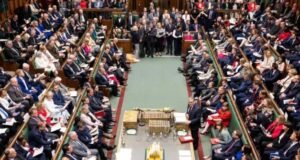
Since becoming prime minister just over a month ago, Boris Johnson has made a number of law-and-order announcements affecting England and Wales.
But what exactly is being proposed?
What it means: There are currently 123,171 police officers in England and Wales, down from 143,000 in 2010, when the Conservatives came to power and Theresa May became home secretary.
So if Mr Johnson delivers on his recruitment plan, it will put officer levels to around where they were nine years ago.
There has been some dispute about the link between police numbers and levels of violent crime, with Theresa May saying there was not a direct link.
But Metropolitan Police Commissioner Cressida Dick has said there is “some link” between the two.
Recruitment of 20,000 new police officers to begin ‘within weeks’
The plan: Up to £2.5bn funding to create 10,000 new prison places.
What it means: The government already had a target, announced in 2015, of creating 10,000 places in new prisons by 2020.
However, this target was to create new places in order to shut old, outdated prisons, not to increase the overall capacity of the prison system.
And the government has now reduced this target to 3,360 by 2023.
But Mr Johnson has now set a new target of another 10,000 by “the mid-2020s”, although it is not clear whether these will replace places lost in closures of older prisons or see a 10,000 increase in overall capacity.
This new target will partly be achieved by expanding HMP Full Sutton, in Yorkshire, although expansion at this site has been planned since 2016.
Currently, the prison population in England and Wales is almost 83,000, which is 8,700 above the prisons service’s own overcrowding limits.
Source: Government prison population bulletin, July monthly figures for England and Wales. *In-use Certified Normal Accommodation (CNA)
And since 2011, those overcrowding limits have been cut by about 2,500 as cells have been closed or fallen into disrepair.
The plan: Police forces across England and Wales will now be able to carry out stop-and-searches in designated areas without authorisation from a senior officer.
What it means: Stop-and-search refers to stopping a person in order to search them for weapons or other prohibited items, such as drugs.
A return to stop-and-stop will represent a big departure from the approach of Theresa May’s government.
Following fears it was being used too widely and unfairly targeting ethnic minorities, especially young black men, stop-and-search fell by 80% between 2009-10 and 2017-18.
Number of stop and searches All stop and search powers, England and Wales
Source: Home Office, year ending March
Under the new plans, some restrictions will be lifted on Section-60 searches.
Currently, Section 60 of the Criminal Justice and Public Order Act 1994 allows officers to search anyone in a designated area – even if they have no reasonable grounds to suspect they are carrying a weapon – as long as they have intelligence of serious violence.
For example, Section 60 was used at last year’s Notting Hill Carnival, in west London, which followed two days in which the city saw five shootings and a fatal stabbing.
But officers will now be able to do so as soon as they have reason to suspect serious violence may take place – and they will no longer require the authorisation of an assistant chief constable.
But Labour’s shadow home secretary, Diane Abbott, says it does not reduce violent crime.
The government’s Serious Violence Strategy, published in April 2018, says knife crime, gun crime and homicide have all risen in recent years as stop-and-search has fallen.
But it dismisses any direct link between the two, saying “the data do not support such a conclusion”.
A 2017 College of Policing study of Metropolitan Police data found higher rates of stop-and-search had seen “very slightly lower than expected rates of crime in the following week or month”.
And a 2016 Home Office analysis was unable to reach a firm conclusion on whether stop-and-search reduced crime or not.
The plan: £85m for the CPS over the next two years
What it means: The CPS deals with the prosecution of those charged with criminal offences.
Since 2010-11, it has had its budget cut by roughly 30% in real terms – a total of about £225m.
In the same period, staff numbers have decreased from 7,978 to 5,518.
Earlier this year, the attorney general said the CPS could not cope with any more cuts.
 Weekly Bangla Mirror | Bangla Mirror, Bangladeshi news in UK, bangla mirror news
Weekly Bangla Mirror | Bangla Mirror, Bangladeshi news in UK, bangla mirror news







